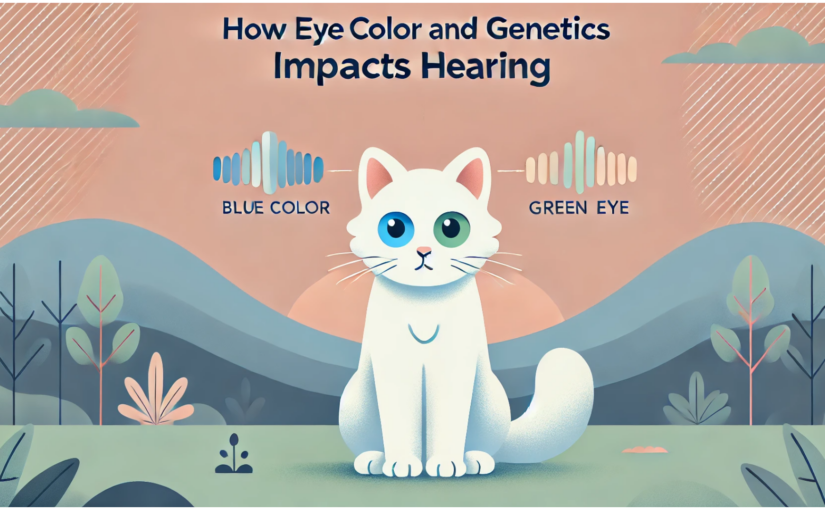We all know cats come in a dazzling variety of colors, but did you know that their eye color might be linked to something unexpected—deafness? This is especially true for certain cats with those mesmerizing blue eyes. If you’ve ever come across a blue-eyed white cat, you may have heard the whispers that they’re often deaf. But how true is this, and why does it happen? Let’s dive into the fascinating world of feline genetics and unravel the connection between cat eye color and deafness.
Why Are Cat Eyes So Fascinating?
Cat eyes are simply mesmerizing, aren’t they? They can range from golden amber to piercing green, and even sky-blue. But unlike us humans, cat eye color isn’t determined by just a few genes. In cats, eye color is a complex genetic trait influenced by the amount of pigment in their iris. The more pigment, the darker the eyes. That’s why you might see anything from copper to green in a kitty’s gaze.
Blue eyes, on the other hand, lack this pigment. Instead of being “colored” by melanin, blue eyes are essentially the result of light scattering in a pigment-free iris—kind of like the sky! And this lack of pigment is where the connection with deafness comes in.
The White Cat and Blue-Eyed Phenomenon
If you’ve ever noticed that many deaf cats tend to have white fur and blue eyes, you’re on to something. The gene responsible for white fur—called the “W” gene—can also interfere with a cat’s hearing. This gene doesn’t just turn a cat’s coat white; it can also block the development of the inner ear, which can lead to deafness.
The reason for this is tied to melanin—the pigment that gives eyes, skin, and fur their color. Melanin also plays a role in the proper development of hearing in the womb. When a cat’s melanin production is disrupted (as it is in white cats), their auditory system may not form properly.
But here’s the kicker: not all white cats are deaf, and not all blue-eyed white cats are affected either! In fact, if a white cat has one blue eye and one differently colored eye, they may only be deaf in the ear on the side of the blue eye. It’s kind of like nature’s little quirk!
Does Every Blue-Eyed Cat Have Hearing Issues?
Not all blue-eyed cats are at risk for hearing loss. It’s the combination of blue eyes and a white coat that typically points to potential deafness. Cats like Siamese, for example, often have striking blue eyes but are rarely deaf. That’s because Siamese cats don’t carry the “W” gene responsible for white fur and associated deafness. Their blue eyes come from a completely different genetic pathway.
For non-white cats, eye color doesn’t have much of a connection to hearing. So, if you have a gorgeous tabby with blue eyes, rest easy—hearing issues likely aren’t in the cards!
How Common Is Deafness in White Cats?
So, what are the chances that a white cat with blue eyes is deaf? According to some studies, about 65% to 85% of all white cats with two blue eyes are deaf to some degree. But the numbers drop for white cats with only one blue eye; roughly 40% of these cats are deaf. For white cats with no blue eyes, the percentage of deafness is much lower—around 10% to 20%.
How Can You Tell If Your Cat Is Deaf?
If you suspect your white, blue-eyed kitty is hard of hearing, there are some telltale signs to look for. Deaf cats might not respond to their name or the sound of you opening a can of food (a noise that usually sends most cats running!). They also tend to sleep very soundly and may startle easily because they can’t hear you approaching.
Deafness can also be confirmed by your vet through a specialized hearing test known as the BAER (Brainstem Auditory Evoked Response) test. This test measures the brain’s response to sound and can tell you definitively if your cat has hearing loss.
Can Deaf Cats Live Normal Lives?
Absolutely! Deaf cats can adapt beautifully to their environment. In fact, many owners of deaf cats say their fur babies are just as playful and affectionate as hearing cats—if not more so! Since they rely on their other senses, they tend to be more observant and attuned to vibrations and visual cues.
However, there are some extra precautions you’ll want to take. For example, if your cat is deaf, they should be kept indoors to protect them from dangers they can’t hear, like cars or predators. You can also use visual or tactile signals, like flashing lights or gentle vibrations, to get their attention.
In Conclusion: A Beautiful Quirk of Nature
Cat eye color and deafness may seem like an odd pair, but they’re an example of how the intricate dance of genetics can create both beauty and complexity. Not every blue-eyed cat is deaf, but in white cats with those enchanting eyes, the likelihood goes up. Thankfully, with a little extra care, even a deaf kitty can lead a full, happy life—maybe even a quieter one!
Want to Learn More?
If you’re curious about the science behind cat eye color and deafness, check out these resources for a deeper dive:






